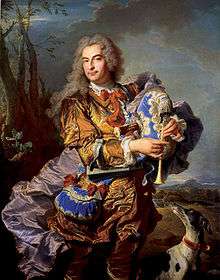Gaspard de Gueidan
| Gaspard de Gueidan | |
|---|---|
 1738 portrait by Hyacinthe Rigaud | |
| Born |
April 10, 1688 Aix-en-Provence |
| Died |
February 23, 1767 Aix-en-Provence |
| Nationality | French |
| Occupation | Public official |
| Religion | Roman Catholic |
| Spouse(s) | Angélique de Simiane |
| Children |
Joseph Gaspard de Gueidan Anne Adélaïde de Gueidan Catherine de Gueidan Pierre Claude Secret de Gueidan Étienne Alexandre de Gueidan Timoléon de Gueidan |
| Parent(s) |
Pierre de Gueidan Madeleine de Trets |
Gaspard de Gueidan (de Valabre) (1688-1767) was a French aristocrat and lawyer. He served as the Président à mortier of the Parliament of Aix-en-Provence.
Biography
Early life
Gaspard de Gueidan was born on April 10, 1688 in Aix-en-Provence.[1][2] He grew up at the Hôtel de Gueydan, located at 22 on the Cours Mirabeau.[3] He was baptised as a Roman Catholic in the Église de la Madeleine in Aix.[4]
His family were bourgeois from Reillanne.[1][2] His grandfather Gaspard Gueidan (1616-1697), married to Catherine Brémond, purchased a position at the Court of Finances, thus becoming a member of the French aristocracy.[2][5] His father was Pierre de Gueidan, a wealthy lawyer, and his mother, Madeleine de Trets.[6]
Career
He entered the Parliament of Aix-en-Provence, where he served as Advocate General, protecting the concerns of the elite.[2][6][7] By the 1730s, his speeches were printed.[2] In 1740, he became Président à mortier of the Parliament of Aix.[2][6][7]
He was a member of the Académie de Marseille and dreamt of being elected to the Académie française.[2]
His portrait was painted by Hyacinthe Rigaud (1659–1743) in 1738.[7][8][9] The painting is based on the character of "Celadon" in L'Astrée by Honoré d'Urfé (1568-1635).[8][9] It is now displayed in the Musée Granet in Aix.[7][8][9]
Personal life
He married Angélique de Simiane, daughter of Joseph marquis de Simiane and Marguerite de Valbelle, on March 24, 1724.[6] They had six children:
- Joseph Gaspard de Gueidan (1725-1784). His second wife was Henriette de Félix d'Ollières. They had a son:
- Alphonse de Gueidan (1783-1853). He married Joséphine Sibillot.
After Joseph's death, Henriette married Jules Lemercier de Maisoncelle de Richemond (1803-1882). After his death, she donated the Château de Valabre to the city of Gardanne.
- Anne Adélaïde de Gueidan (1725-1786). She married Pierre Louis de Demandolx La Palud on January 24, 1745. She was also the mistress of Giacomo Casanova (1725-1798) by some accounts.[10]
- Catherine de Gueidan (1728-1759). She married Claude de Prats on August 4, 1749.
- Pierre Claude Secret de Gueidan (1733-unknown). He became a Knight of Malta.
- Étienne Alexandre de Gueidan (1735-unknown). He also became a Knight of Malta.
- Timoléon de Gueidan (1744-unknown). He also became a Knight of Malta.
He died on February 23, 1767 in Aix-en-Provence.
Bibliography
- Gaspard de Gueidan, Discours prononcés au Parlement de Provence par un de messieurs les avocats généraux (Volumes 1 and 2, chez Quillau, 1739).[11]
- Gaspard de Gueidan, Discours prononcés au Parlement de Provence par un de messieurs les avocats généraux (Volume 2, 1741).[12]
- Gaspard de Gueidan, Discours prononcés au parlement de Provence (Volume 3, de Nully, 1753).[13]
- Gaspard de Gueidan, Discours prononcés au parlement de Provence (Volume 5, 1762).[14]
References
- 1 2 Monique Cubells, La Provence des lumières : Les parlementaires d'Aix au XVIIIe siècle, Paris: Maloine, 1984, p. 42
- 1 2 3 4 5 6 7 Christian Wieland (ed.), Jörn Leonhard (ed.), What Makes the Nobility Noble?: Comparative Perspectives from the Sixteenth to the Twentieth Century, Vandenhoeck & Ruprecht, 2011 p. 283
- ↑ Ambroise Roux-Alphéran, Les Rues d'Aix, Aubin, 1848
- ↑ Bertrand Jestaz, Art et artistes en France de la Renaissance à la Révolution, Paris: Bibliothèque de l'École des Chartes, 2003, p. 259
- ↑ Michel Vovelle, Les folies d'Aix ou la fin d'un monde, Le temps des cerises, 2003, p. 182-183
- 1 2 3 4 Myra Nan Rosenfeld, Largillierre and the eighteenth-century portrait, Montreal Museum of Fine Arts, 1982, p. 299
- 1 2 3 4 Katharine Baetjer, Pastel Portraits: Images of 18th-Century Europe, Metropolitan Museum of Art, 2011, p. 19
- 1 2 3 Joanna Woodall, Portraiture: Facing the Subject, Manchester University Press, 1997, p. 69
- 1 2 3 Michael Levey, Painting and Sculpture in France, 1700-1789, Yale University Press, 1993, p. 7
- ↑ Judith Summers, Casanova's Women: The Great Seducer and the Women He Loved, Bloomsbury Publishing, 2012, pp. 144-167
- ↑ Google Books
- ↑ Google Books
- ↑ Google Books
- ↑ Google Books